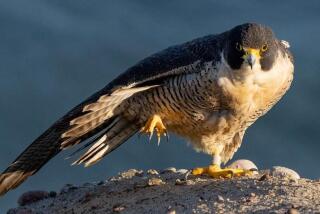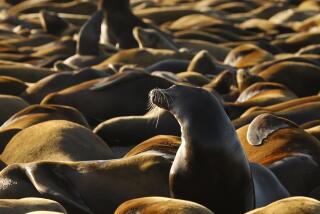Brown Pelicans, Once Nearly Extinct, Are Flying High
ANACAPA ISLAND, Calif. — The U.S. Fish and Wildlife Service is considering downgrading the status of the California brown pelican from endangered to threatened because of the bird’s remarkable recovery from the brink of extinction.
The existence of the pelicans was in jeopardy 20 years ago because of DDT, a pesticide that induced a malady resulting in eggshells so thin that mother birds crushed them in the nest.
In 1970, only one pelican chick survived at Anacapa Island, the primary U.S. nesting site for the birds.
Since then, with the protection of the National Park Service and with a ban on DDT, the birds have re-established a permanent colony here. In a dramatic reversal, pelican reproduction increased from the sole chick in 1970 to 6,497 newborn pelicans surviving on the island in 1985, the peak year so far.
The impetus for the downgrading of the birds’ status came from Frank Gress and Dan Anderson, UC Davis marine biologists. They define an endangered species as one in danger of extinction. A threatened species is one that could become endangered in the foreseeable future.
Before the reclassification can occur it must be approved for consideration by the Fish and Wildlife Service. After that, public hearings would be held before a final determination.
Anderson, who estimates the California brown pelican population at 70,000 to 90,000, believes it is important to change the classification because “this is truly a success story, one of the few endangered species in the country that has shown encouraging signs of recovery. The bird in its threatened status will still be protected by the Endangered Species Act.”
According to Gress, the spurt in pelican population is unprecedented. “The years 1985, 1986 and 1987 were incredible,” he said. “We don’t have anything on record 100 years back that shows production this high--6,497 fledged on Anacapa alone in 1985, 4,601 in 1986 and 4,398 in 1987.
“But there is a huge amount of variance,” Gress said. “In 1984, for example, there were 848 nests and 584 birds produced. In 1988, the nests dropped (from the 1985-87 peak years) to about 3,000 with 2,400 birds produced and it appears the numbers will be about the same this year.”
Variances in chick production depend on a number of factors, such as availability of food to the nesting colonies--the birds often fly 20 to 30 miles round trip to find anchovies--and disturbances by other wildlife or by man. Pelicans’ natural enemies include gulls that eat eggs and rats that eat pelican chicks.
David Lewis, a UC Santa Cruz sea bird expert, believes that there is even the possibility that overcrowding in the Anacapa nesting colony in previous years could have discouraged some of the birds from returning to the island to nest.
Lewis agrees with the reclassification proposal.
“California brown pelicans have demonstrated it is possible for an endangered species to have a success story with proper protection, with proper management,” he said. “It’s time to seriously consider changing the pelican’s status.”
Lewis has been under contract to the National Park Service for five years to monitor population dynamics of the brown pelican at Anacapa and Santa Barbara islands, the two local nesting areas.
“They’re heroic, noble creatures. I never tire of watching them,” he said as he observed the birds nesting one recent weekend on Anacapa, one of a chain of three small islands off the Southern California coast that is part of Channel Islands National Park.
Like a squadron of fighter planes, several of the birds, 3 1/2 feet tall with 7-foot wingspans, flew low in single file, barely clearing the waves just off the island near the nesting colony.
Other pelicans made spectacular 30- to 40-foot dives from cliffs into the sea to catch fish in their long, flat bills.
Pelican Sanctuary
West Anacapa Island is a pelican sanctuary. No one except scientists conducting pelican studies is permitted to come ashore except in a restricted beach area.
During each visit to the nesting colonies, Lewis peers through his binoculars and jots notes on the numbers of nests, eggs and newborn pelicans.
The nests are built of sticks on island cliffs, slopes and rocks. Pelicans come into the colonies in waves from December through May to lay eggs. The incubation period is 30 days.
The last of the chicks are fledged in July. It takes 10 to 12 weeks from the time the birds hatch until they learn to fly. They then leave to cruise the coastal waters for food--anchovies, sardines, herring and mackerel--traveling as far north as Washington.
“A nest will have one to three eggs,” Lewis said. “Pelican chicks squawk raucously for food. They know their parents by sight and their parents know which chicks to feed.
“Once the birds fledge, they become silent, never uttering a sound. Mortality is extremely high among fledglings. But those that make it . . . live to be as old as 40.”
Fly North
After nesting, the pelicans fly north and disperse along California, Oregon and Washington until they return to the California and Mexican islands to start the cycle over again.
Gress has studied pelicans since the early 1970s on Santa Barbara and Anacapa islands, as well as the Coronado Islands six miles off Tijuana, where about 85% of California brown pelicans breed and nest.
He and other pelican experts have been urging Mexican Fish and Wildlife authorities for years to establish a pelican sanctuary on two unoccupied islands in the Mexican archipelago to protect the bird.
Gress said people gather pelican and sea gull eggs from nests and sell them to bakeries and restaurants in Tijuana as substitutes for chicken eggs.
He was on one of the Coronado Islands on a recent weekend and found 700 deserted pelican nests. “It appeared ‘eggers’ had been on the island looking for fresh eggs and spooked the pelicans away before they had a chance to lay them,” he said.
More to Read
Sign up for Essential California
The most important California stories and recommendations in your inbox every morning.
You may occasionally receive promotional content from the Los Angeles Times.










